| Srl | Item |
| 1 |
ID:
180615
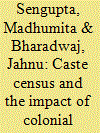

|
|
|
|
|
| Summary/Abstract |
This essay challenges the salience of the caste question for writing a social history of modern Assam. It argues that pre-colonial records contained enough indicators for arguing that caste in Assam was never a rigid and impermeable social grid. The variegated nature of Assam’s geo-political and cultural past meant that the progress of Brahmanical culture here was neither smooth nor unmitigated. The essay argues that the region’s social and cultural intricacies could not be comprehended through an interpretive framework developed in a pan-Indian context. The same was, however, used by the census officials to streamline the region’s discrete patterns into rigidly structured hierarchies and uniformly imagined categories. Through a close reading of the pre-decennial and decennial census reports and other records from the nineteenth century, this essay identifies numerous misreading of local level empirical data that enabled the British to produce a uniform caste history for the region.
|
|
|
|
|
|
|
|
|
|
|
|
|
|
|
|
| 2 |
ID:
180616
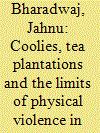

|
|
|
|
|
| Summary/Abstract |
The paper seeks to locate the violence perpetrated on the bodies of the coolies in colonial Assam. The paper observes that the existing historiography on tea plantations in colonial Assam restricts corporeal violence on the coolies within the boundaries of the plantation estates and does not talk about the permeation of such violence to spaces and coolies totally outside of the plantation production process. This paper, with the evidence from a case from nineteenth-century Assam, extends the limits of corporeal violence on the coolies beyond the physical setup of the plantations. The paper proposes that histories of corporeal violence on labour in the colonial era need to look beyond the peripheries of the plantations and towards the social regimes of power under colonialism. The paper demonstrates the complicit character of the state and newly landed and moneyed native classes in the colony, which aggravated the magnitudes of violence on labour.
|
|
|
|
|
|
|
|
|
|
|
|
|
|
|
|
| 3 |
ID:
180618
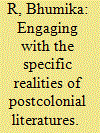

|
|
|
|
|
| Summary/Abstract |
Contemporary Naga literature in English engages with aspects of State-making, nationalism while it lives in a moment identified as the global. It also inhabits the ‘postcolonial’ terrain given its history of British Colonisation. In other words, even as contemporary Naga literature in English engages with features broadly identified as constituting the postcolonial, due to the multiple socio-political realities it inhabits, it also needs to be read in terms of its specificities. Since contemporary Naga literature in English is embedded in multiple realities, locating it within a single theoretical trajectory can be difficult. This paper attempts to demonstrate that while literatures can be mapped as belonging to the ‘postcolonial’ time, it is difficult to map similarities across literary writings, in terms of literary articulation.
|
|
|
|
|
|
|
|
|
|
|
|
|
|
|
|
| 4 |
ID:
180614
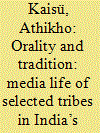

|
|
|
|
|
| Summary/Abstract |
Long before the onset of information revolution, human society has strong tradition of media life. Media is cultural deterministic and embedded in everyday lifeworld of human society. Mediated and saturated media world is not the only factor that makes media popular although media studies and communication as discipline is a modern phenomenon. Human beings have been using effectively to convey and communicate message through their everyday life experience and social practices since ages. Whatever human beings practice and do convey some meaning so it is the message. Oral culture is constantly reinforced in the form of retelling and renarrating of what we have heard and learnt from other mediums thereby making orality ubiquitous in some way or the other.
|
|
|
|
|
|
|
|
|
|
|
|
|
|
|
|
| 5 |
ID:
180617
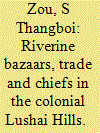

|
|
|
|
|
| Summary/Abstract |
The Lushais maintained commercial contact with the surrounding plains traders in the eighteenth and nineteenth century. The British administrators recognised the importance of trade and bazaar in relation with independent Lushai chiefs and to use them as a diplomatic tool to influence the behaviour of the Lushais. The British introduced riverine bazaars in the interiors of Lushai hills to satisfy Lushais’ desire for tradable commodities; to facilitate the interests of plain merchants in a profitable rubber trade; and to provide security to their subjects within their territories. The failure on the part of the Lushai chiefs to provide security to the marketplaces and resumption of raids in the British territories paved the way for the British to directly interfere in the Lushai affairs. This paper contradicts the Romantic notion of Lushai village communities being self-supporting and isolated autarchy and the notion of self-sufficiency of ‘Indian village communities’ as propagated in the nineteenth century.
|
|
|
|
|
|
|
|
|
|
|
|
|
|
|
|
| 6 |
ID:
180619


|
|
|
|
|
| Summary/Abstract |
It was a Chinese face that seemed most familiar to me. Dressed in the green uniform of PLA and holding a black and cold pole, the expressionless soldiers are beating the Tibetan protesters with his foot stepping down on their bodies. Shouts and moaning immersed the city of gray, and the crowd of irresistible hatred, spilling from the screen. Then I saw an older man, wise and solemn, wearing a red robe that slightly thaws my tightened heart. It’s the Dalai Lama, I realized, the spiritual backbone of the Tibetans and the evil splitter according to what I have been taught since a little girl. Looking into his eyes, I saw a lake ruffled by the breeze, disturbing and unsettling. It is the unease of bearing violence as a non-violent leader, the frustration of witnessing his people being tortured, and the pain of serving as the original sin of other’s sufferings. For the very first time, I saw the Dalai Lama as an ordinary person, someone who cries for his trauma instead of containing all misfortunes and unfairness.
|
|
|
|
|
|
|
|
|
|
|
|
|
|
|
|